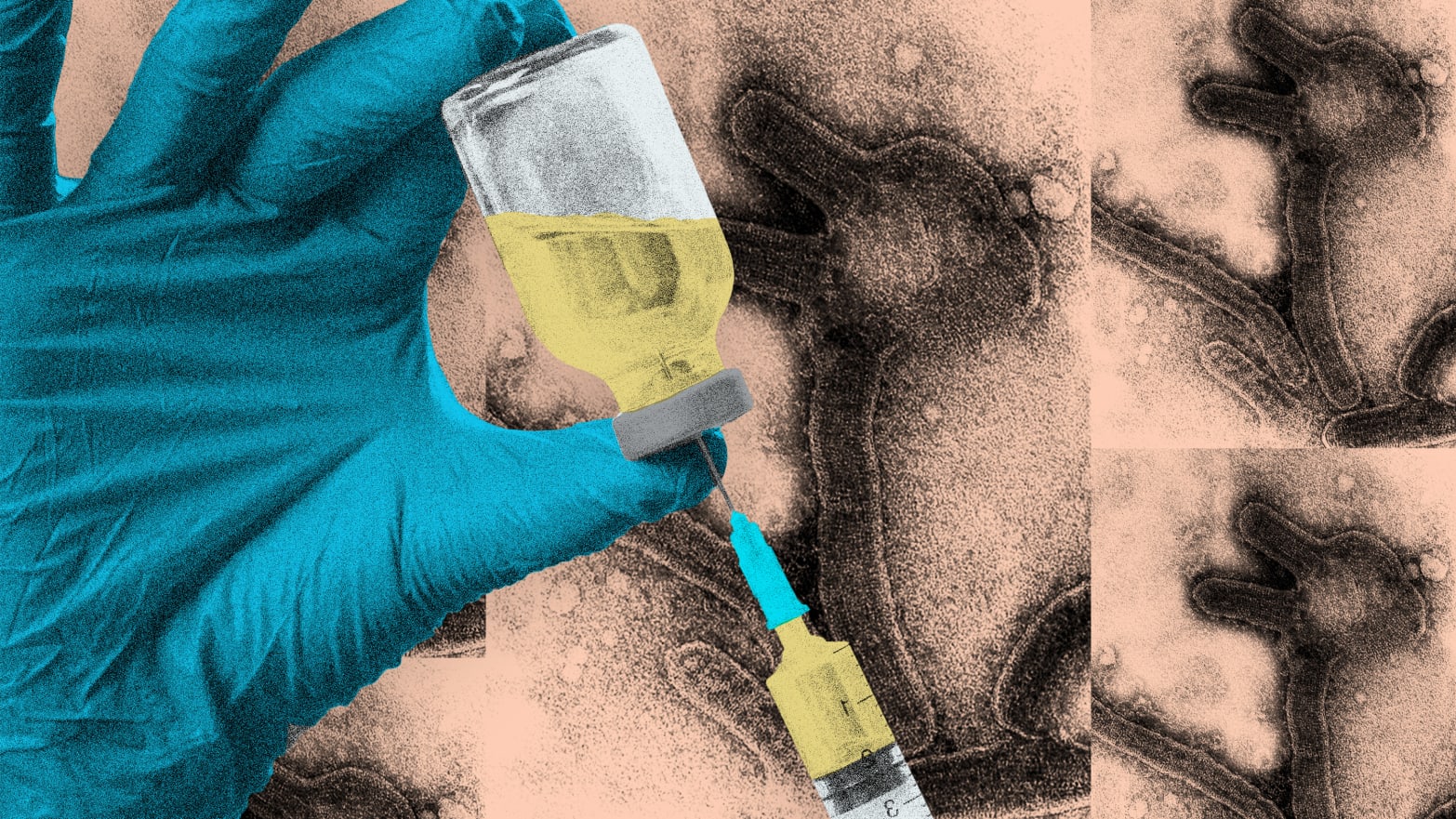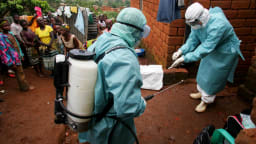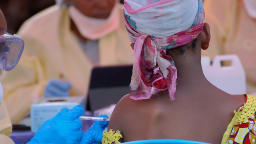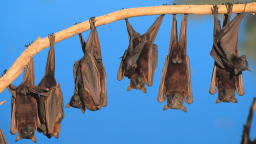THE HOT ZONE
Stopping a Marburg virus outbreak is hard enough. Preventing the next one is even tougher.
Maddie Bender
Innovation Reporter
Published Apr. 10, 2023

Photo Illustration by Elizabeth Brockway/The Daily Beast/Getty/CDC
The past few weeks have brought with them unsettling news from both East Africa and Central Africa, as Equatorial Guinea and Tanzania have independently announced outbreaks of deadly Marburg virus. The first outbreak, which began in mid-February in Equatorial Guinea, has thus far consisted of at least 29 confirmed and probable cases, 27 of which have proved fatal. Tanzania’s Marburg outbreak was announced on March 21—so far, eight people have been symptomatic for the disease, and five have died. And the Centers for Disease Control and Prevention is asking American doctors to be on the lookout for cases stateside, though the risk of the virus in the U.S. is low.
Marburg virus may not be as terrifying as it was portrayed in 1994’s The Hot Zone, but any outbreak is concerning to infectious disease experts. First described in 1967 in Marburg, Germany, it is a deadly hemorrhagic fever in the same family as Ebola. The virus infects Egyptian fruit bats and can spill over to humans who come into close contact with the animals or their excretions. A person can also contract the virus from someone who’s infected if they come into contact with body fluids, contaminated clothes or bedding, or someone who has died from the virus. A Marburg virus infection is fatal in between 20 and 90 percent of all cases.
Based on these characteristics, you might think that humans would have figured out a vaccine for Marburg yesterday. You’d be partially right: Although a handful of research organizations are working independently on vaccine candidates, no vaccine has been approved to prevent viral infection, and no antiviral has been approved to treat it. Two of these vaccine candidates—made by Janssen Pharmaceuticals and the Sabin Vaccine Institute, respectively—have been tested in humans, but neither has been put through the typical wringer of safety and efficacy trials. And, as both outbreaks come under control, researchers may have missed their chance to deploy and test promising vaccine candidates.
Equatorial Guinea Confirms Outbreak of Marburg Virus Disease
ALARMING

There are several reasons why we haven’t yet come up with an approved vaccine for Marburg, Robert Cross, a virologist at Galveston National Laboratory, told The Daily Beast in an email.
One of the most salient is that “there really have not been that many outbreaks,” said Cross. “However, as we all know, when these outbreaks occur, they come with extremely dire outcomes, often with many dead.” It’s a blessing and a curse for public health researchers that Marburg outbreaks have historically been few and far in between, as a vaccine can’t be tested if people are never infected.
Few cases means there are financial incentives for drug companies to want to make a vaccine. Nonprofit and government-funded research institutes are also working on vaccine candidates, but don’t have surplus doses on hand to ship out to the countries affected by ongoing outbreaks. And there’s a time limit on the whole process, too: It takes a person between two and 21 days to develop symptoms of Marburg infection, and their condition can rapidly deteriorate within an additional week. When a case is identified, it takes time and resources to identify everyone who could have been exposed to them—in Equatorial Guinea’s outbreak, these close contacts have numbered in the hundreds for some cases.
Doctors Without Borders Slams ‘Rationing’ of Ebola Vaccine
TAKING A SHOT

Keeping in mind all these challenges, the best strategy to test potential vaccines would follow a technique used during the eradication of smallpox, called ring vaccination. The process involves identifying a “ring” of close contacts to a positive case, then vaccinating them as well as their close contacts, just to be safe.
In a December 2022 paper published in the journal Clinical Trials, an international group of Marburg virus researchers described two ways such a vaccination strategy might work: First, between outbreaks, researchers could identify populations who are at high risk for coming into contact with infected bats or living in areas where Marburg virus has been known to spread, and randomize people to receive a candidate vaccine. These people would need to be followed over a long period of time in order for researchers to collect data on how well a vaccine might protect them against a viral outbreak.
For the second option, public health officials could ring vaccinate households or close contacts during an ongoing outbreak using different vaccine candidates, and compare the effectiveness of different vaccines against each other by studying which households were better protected from infection.
“When these outbreaks occur, they come with extremely dire outcomes, often with many dead.”
— Robert Cross, Galveston National Laboratory
If it isn’t clear, both of these strategies require an immense amount of health-care staff, time, and money. As Cross put it, “These kinds of trials would really only be possible where adequate funding to support stockpiling of clinical-grade material is possible—a point that has been a continual challenge” for emerging pathogens like Marburg.
Moreover, we still don’t know very much about which regions support the highest concentrations of Marburg-infected bats, how Marburg virus spills over to humans, and what populations are most at-risk during outbreaks. Drilling down into these questions would help researchers use a finite number of vaccines wisely.
Some of this work is already being undertaken. In 2020, for instance, researchers in the U.S. and Sierra Leone identified Egyptian fruit bats carrying the virus in four different districts in Sierra Leone. While there has not yet been an outbreak of Marburg virus in the country, its neighbor to the north—Guinea—declared an outbreak the next year. To Cross, this represented a success of public health surveillance. Scientists were able to detect the virus in a region before an outbreak began, raising the possibility that future spillover events could be predicted.
Want to Stop the Next Pandemic? Protect Wildlife Habitats
MOTHER NATURE
Tony Ho Tran

Given the low incidence of Marburg outbreaks in the past, the fact that two have sprung up independently from one another in nearly the same month should set off alarm bells on more than count, Cross said. New spillover events speak to a lack of public health investment or follow-up on known risks, like proximity to the bats infected with Marburg.
“These two outbreaks are unfortunately the product of insufficient public health investment in surveillance,” he said. “We know what the reservoir for this virus is, yet we are not investing in better understanding of how the ecology of the reservoir bat is being impacted by such issues as deforestation or even global warming.”
“These two outbreaks are unfortunately the product of insufficient public health investment in surveillance.”
— Robert Cross, Galveston National Laboratory
Indeed, multiple studies over the past several years have supported the “One Health” hypothesis—that environmental, animal, and human health are interconnected. The destruction of natural ecosystems and the spread of human development to more and more places means humans and wildlife are in closer contact than ever before—increasing the risk of more diseases to jump from species to species until human communities are hit. Though the origins of COVID-19 are still a contested topic, most scientists seem to agree the virus jumped from an animal population (like raccoon dogs) into humans.
It’s worth noting that the World Health Organization has not published new statements about the Equatorial Guinea and Tanzania outbreaks since late March, suggesting that both may be winding down. But we’re not out of the woods for good—if anything, the opposite is true. Human expansion, environmental destruction, and infectious disease spillover are all taking place in a dire cycle. We can be sure that these outbreaks will occur more and more often, so it is imperative that we disrupt the cycle or prevent its deadly effects by pushing forward vaccines and new therapeutics.
No comments:
Post a Comment